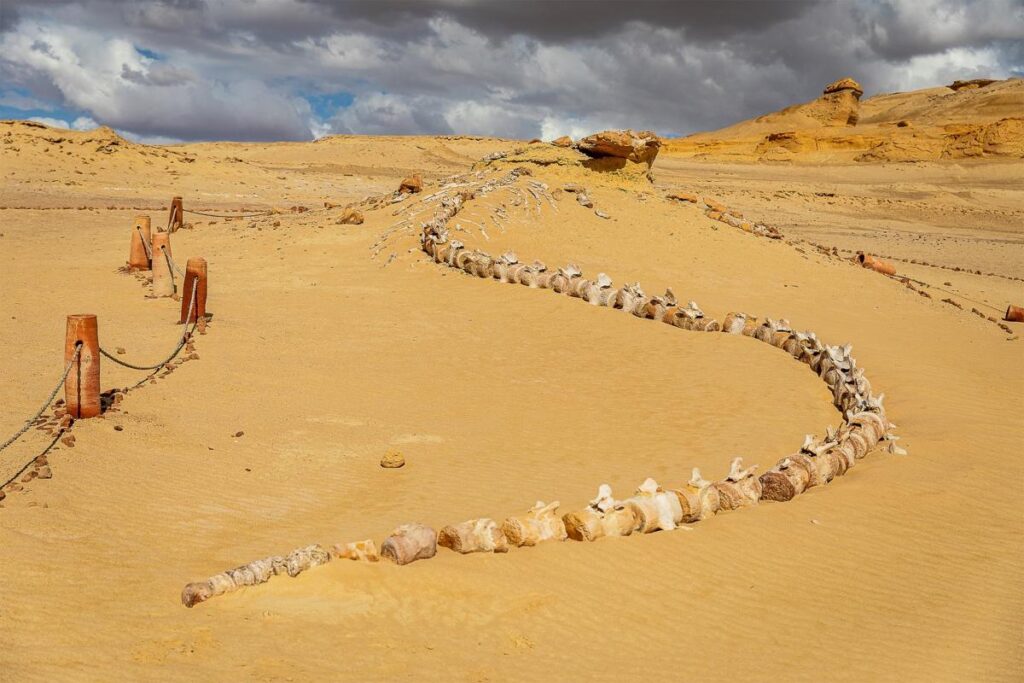Wadi al-Hitan, a 75-square-mile UNESCO World Heritage Site located approximately 100 miles southwest of Cairo, reveals a paramount chapter in Earth’s evolutionary history. Unlike the lavish remnants of ancient Egyptian civilization, such as Tutankhamun’s gilded death mask and the Sphinx, Wadi al-Hitan transports visitors to a more primordial time when massive marine creatures roamed the seas that once flooded this region. This largely overlooked site features vast stretches of desolate desert devoid of modern life but enriched with a profound geological narrative that has been partially unveiled through the relentless processes of erosion and dedicated paleontological work over the years.
Visitors to Wadi al-Hitan are greeted by an eerie tranquility as they traverse the relentless sands and the unique geological formations shaped by time. The landscape hosts an array of fossils, including smooth mollusk shells, coin-shaped nummulites, and even sharks’ teeth—all telltale signs of a marine environment that existed around 40 million years ago when the area was submerged in the Tethys Ocean. Amid the wind-sculpted rocks, hints of prehistoric life await discovery, leaving an air of mystery over a desert that seems lifeless by comparison to the abundant archaeological wealth typically associated with Egypt’s more famous sites.
The true significance of Wadi al-Hitan comes to life through its astonishing paleontological records, particularly the well-preserved skeletons of ancient whales scattered throughout the valley. Among these remarkable finds is the “Basilosaurus,” initially misidentified as a giant marine reptile; it epitomizes the transitional phase in whale evolution from land to sea. More than 1,000 individual remains have been cataloged here, marking Wadi al-Hitan as the world’s largest whale cemetery and an essential location for understanding the evolutionary journey of cetaceans. The site aptly bears the name “Valley of the Whales,” akin to the famed Valley of the Kings.
As visitors explore this unique paleontological treasure, they can examine around a dozen skeletons that stand as monumental reminders of the past. These remnants, dated to the late Eocene period, enhance the expansive narrative of evolution while allowing onlookers to appreciate the scale and diversity of prehistoric marine life. The skeletal remains, connected by neatly laid paths, create an almost museum-like atmosphere out in the open desert, inviting curiosity and reflection on the shifts in Earth’s biological landscape over millions of years.
Further enriching the visitor experience is a subterranean museum that houses additional fascinating finds from Wadi al-Hitan, including well-preserved Basilosaurus skulls showcasing formidable teeth. However, the most striking display is the tiny hind leg bones discovered in 1989, which serve as a crucial link in understanding the evolutionary transition of whales from terrestrial to aquatic life. These seemingly insignificant limb remains, though not suited for walking, provide compelling evidence that whales indeed descended from land-dwelling ancestors before evolving to dominate the oceans.
In summary, Wadi al-Hitan offers a captivating glimpse into one of nature’s most compelling stories—evolution itself. The juxtaposition of its barren, wind-swept landscape with the rich, fossilized remnants of marine life illustrates a dynamic history that continuously unfolds beneath our feet. As one of the most important paleontological sites in the world, it stands as a testament to understanding not only the past—but also the profound interconnections that define life on Earth. For those who venture into this desolate yet historically rich territory, the experience becomes a physical and intellectual journey into the very heart of evolution, revealing insights that resonate across the ages.

